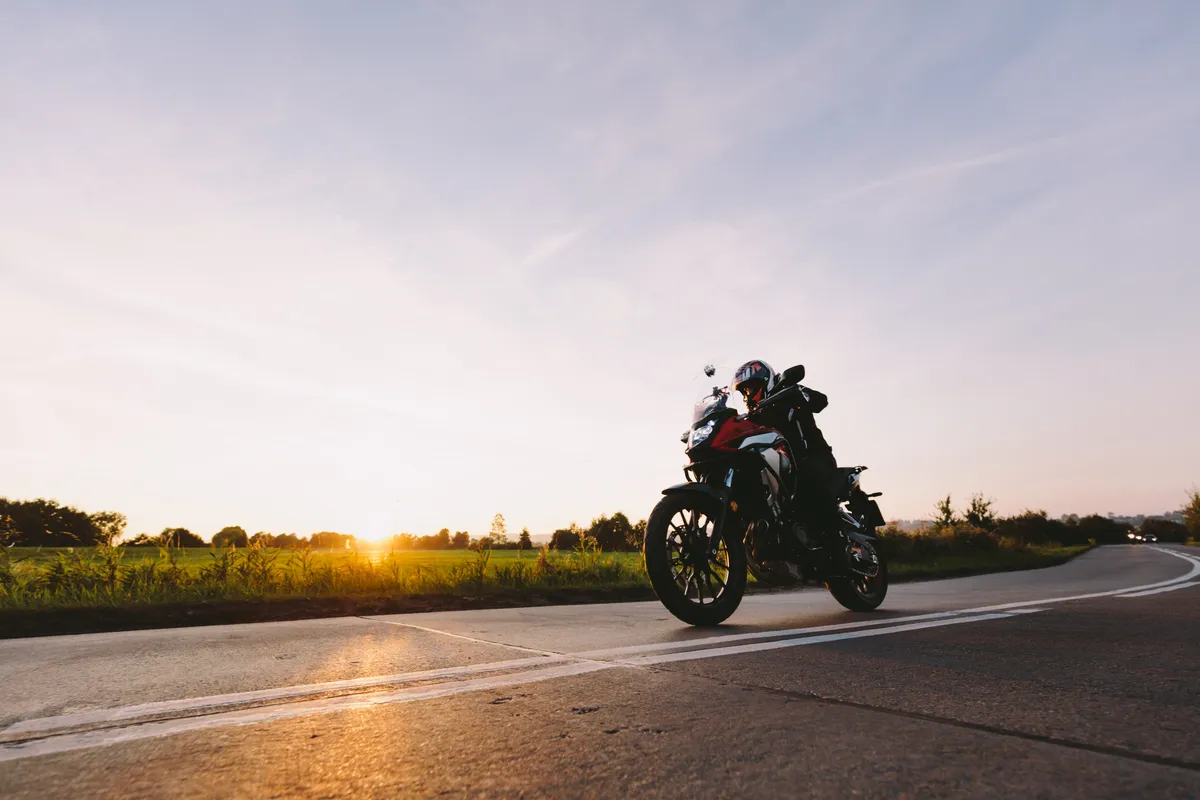7 min read time
Table of Contents

Is Lane Splitting Legal in Las Vegas?
According to Nevada Revised Statutes (NRS) 486.351, lane splitting is illegal in Nevada.
This means motorcyclists cannot ride between lanes or rows of vehicles in the same traffic lane.
Is Lane Filtering Legal in Nevada?
Nevada law does not differentiate between lane splitting and lane filtering, meaning lane filtering is illegal in Nevada.
Is Lane Sharing Illegal in Nevada?
Under NRS 486.351, Lane sharing is legal in Nevada. NRS 486.351 states:
"Motorcycles are entitled to full use of a lane, and no motor vehicle shall be driven in such a manner as to deprive any motorcycle of the full use of a lane. This does not apply to motorcycles operated two abreast in a single lane."
Lane sharing occurs when two motorcycle drivers ride side by side in the same lane.
Although lane sharing is permitted by state law, the two motorcyclists partaking in it must be skilled motorcyclists familiar with Nevada motorcycle laws.
Punishments For Lane Splitting in Nevada

Motorcycle Lane splitting is prohibited in Nevada, according to NRS 486.351. This statute says motorcyclists shall not operate between lanes of traffic or rows of vehicles. The statute states:
"A person operating a motorcycle shall not overtake and pass in the same lane occupied by the vehicle being overtaken."
How Much Is a Ticket for Lane Splitting in Nevada?
The fine for lane splitting can vary but is usually $190 to $300.
The exact fine will depend on the county or city in Nevada where you were ticketed. In Las Vegas, for example, the fines are the same as the state.
Repeated violations can result in higher fines, more points on your record, motorcycle license suspension, and possibly criminal penalties.
What Is the Difference Between Lane Splitting and Filtering?
Lane Splitting
Lane splitting occurs when a motorcycle driver goes between traffic lanes that are slow-moving or stopped.
This happens on highways or multi-lane roads where traffic is congested. Key points are:
Location: Between lanes of traffic, usually on highways or multi-lane roads.
Traffic Conditions: Slow-moving or stopped traffic.
Speed Differential: Motorcyclists are faster than the surrounding vehicles but not much faster to avoid a motorcycle accident.
Goal: Splitting lanes aim to get past slow or stationary vehicles.
Lane splitting is controversial because of the safety risks, including the possibility of a lane-splitting accident.
Filtering
Filtering is when a motorcyclist moves between stationary or very slow-moving motor vehicles to reach the front of the line at a red light or in heavy congestion.
Unlike lane splitting, filtering is usually in specific situations, such as intersections or stop-and-go traffic. Here are the key points:
Location: At intersections or heavy traffic congestion.
Traffic Conditions: Vehicles moving in the same direction are usually stationary or moving very slowly.
Speed Differential: Motorcycle operators move slowly enough to get through the traffic safely.
Goal: To get the motorcycle to the front of the traffic queue, reduce idle time, and often improve visibility and safety when the light changes.
Filtering is considered less risky than lane splitting because it’s done at lower speeds and in more controlled situations.
However, lane filtering is still considered dangerous, with the risk of vehicles changing lanes or opening doors; if you're asking, 'Is lane filtering legal in Nevada? ' The answer is no; it's not legal.
What Percentage of Motorcycle Accidents Are Caused by Lane Splitting?

The percentage of motorcycle accidents caused by lane splitting varies from study to study and region to region, but here are some common findings.
Studies and Stats
California Study (2015)
The most comprehensive study on lane splitting was done by the University of California, Berkeley, using data from the California Highway Patrol (CHP). This study looked at motorcycle collisions from 2012 to 2013. Key findings:
Lane splitting was involved in 17% of motorcycle accidents during the study period.
Motorcyclists who were lane splitting were found to be less likely to suffer head, torso, and fatal injuries than those who weren’t lane splitting, as long as they were going less than 50 mph and no more than 15 mph faster than other drivers.
NHTSA Report
NHTSA data shows that lane splitting can be a factor in motorcycle accidents, but they usually say most accidents are caused by driver inattention, alcohol use, and speeding. They don’t usually break out the numbers for lane splitting alone.
IIHS Findings
IIHS says the risk of lane splitting is closely tied to the speed difference between the motorcyclist and the other drivers. Lower speed differentials reduce the risk of accidents and injuries.
What Is the Reason for Lane Splitting?
Lane splitting, the practice of motorcyclists riding between lanes of slow-moving or stopped traffic, is a hot topic but has several motivations and benefits that support it.
Understanding the reasons behind lane splitting will help you see why many riders consider it a good practice and why it’s even legal and regulated in some areas.
Reasons for Lane Splitting
Reducing Traffic Congestion
Lane splitting allows a motorcyclist to bypass slow-moving or stopped traffic, reducing the number of vehicles in the traffic lane.
This makes for a smoother traffic flow as the motorcyclist won't add to the congestion.
Saving Time
A motorcyclist can reduce their commute time by moving between lanes, especially during peak hours. This is good for the rider and helps reduce overall traffic on the road.
Reducing Rear End Collisions
Motorcycles are more prone to rear-ended in stop-and-go traffic due to their size and distracted driving.
Lane splitting helps motorcyclists avoid this risk by allowing them to keep moving rather than stop in a traffic line where they are less visible.
Rider Comfort and Safety
In hot weather, idling in traffic can cause the motorcycle to overheat and the motorcyclist to become uncomfortable.
Lane splitting keeps the motorcycle moving, maintaining airflow around the engine and rider, making it more comfortable while preventing overheating.
Reducing Pollution and Fuel Consumption
Motorcycles that move rather than idle in traffic are more fuel-efficient and produce fewer emissions. This is especially true in big cities where air quality is a concern.
Where Is Lane Splitting Legal
Lane splitting, the act of motorcyclists riding between lanes of slow-moving or stopped traffic, is legal in some areas but not everywhere. Its legality varies from state to state.
California
California is the only US state where lane splitting is legal. The California Highway Patrol (CHP) has guidelines for safe lane splitting: don’t go more than 10 mph faster than surrounding traffic, and only lane split when traffic moves at 30 mph or less.
Utah
Utah has legalized a form of lane splitting called “lane filtering,” in which motorcyclists can move between lanes of stopped traffic at intersections.
Why Isn’t Lane Splitting Legal Everywhere
Despite the benefits and legality in some areas, lane splitting is not legal everywhere. Here’s why:
Safety Concerns:
Sudden lane changes by drivers, car door openings, and unpredictability of traffic can create dangerous situations for motorcyclists, resulting in a lane-splitting accident.
Driver Awareness and Behavior:
Lack of awareness or distracted driving can lead to hazardous situations, as drivers may not check their mirrors for motorcycles.
Traffic Laws and Enforcement:
Many jurisdictions have traffic laws that don’t accommodate lane splitting. They focus on uniformity and simplicity in lane usage.
Public Perception:
Many people consider line splitting dangerous or unfair. Drivers may view it as a reckless maneuver that disrupts traffic flow.
Infrastructure and Road Design:
The design of roads and lanes can affect the feasibility of lane splitting. In areas with narrow lanes or inconsistent road conditions, lane splitting can be more difficult and risky.
Talk with a Motorcycle Accident Attorney Today
If you were involved in a motorcycle accident in Las Vegas, you can seek to file an insurance claim and recover compensation. We can help.
With over 20+ years of experience, attorneys have the skills and knowledge to win your case.
Schedule a free consultation today by calling (702) 566-3600.
Obtain the Compensation You're Entitled To
Contact Us Today
Rodney Okano Car Accident Lawyer is a Las Vegas personal injury law firm with over 20 years of experience helping clients obtain maximum compensation following injuries from accidents such as car crashes, worksite injuries, and slips and falls. Over those years, The Rodney Okano Car Accident Lawyer Law Firm has become an experienced law firm that can ensure exceptional results for any of its clients.





